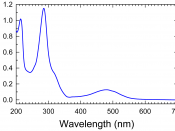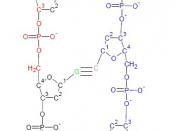I.Introduction
DNA is short for Deoxyribonucleic Acid. DNA is a molecule that forms your chromosomes and genes, and contains all of your genetic material. It is contained in the nucleus of all the cells in your body. Although they may be in all your cells, the cell has the ability to turn off or on that particular gene. Thus you don't get a brain in your foot. Because no two people have the same DNA, excluding Identical Twins, the world today uses it for giving a body an ID; it is used in forensics, as well as to determine who the father of a certain baby is.
DNA's structure was discovered by Watson and Crick in 1953. DNA is a double helix made up of a phosphate unit, deoxyribose sugar, and nitrogen bases. The bases are made up of 2 different types of Purines, Adenine and Guanine, and Pyrimidines, Thymine and Cytosine.
The Purines have 5 nitrogen atoms; the Pyrimidines contain 2, therefore receiving the term Nitrogen Base. Together the phosphate unit, nitrogen unit, and deoxyribose sugar make up a nucleotide. The nitrogen base always bonds (attaches) to the sugar unit (deoxyribose). Thymine, Tfor short, always bonds with Adenine (A). While Guanine (G) always bonds with Cytosine (C). DNA also codes for your protein, what proteins to make, and how to make them. However, DNA stays in the nucleus. So RNA (ribonucleic acid) takes on the job of copying the DNA's message to carry to the ribosome outside the cell's nucleus.
DNA copies itself by unzipping down the middle of the two nitrogen bases which can happen because the two bond together through weak hydrogen bonds.
In order to identify DNA scientists use Restriction Enzymes to cut up DNA through a series of patterns. Police and Law Enforcement Officers...



DNA lab write-up
Thorough, informative and detailed.
Definitely a help for research.
Good Job, ccmustangs2001.
2 out of 2 people found this comment useful.